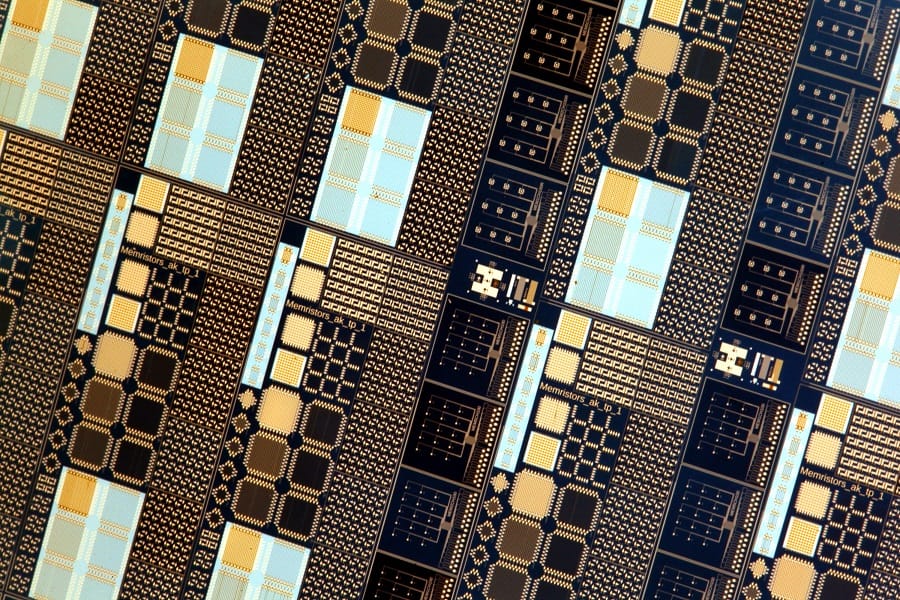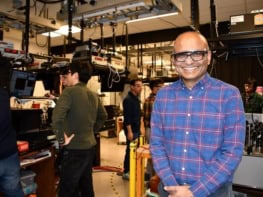
In just 10 years the memristor has developed from Leon Chua’s “lost circuit element” found by researchers led by Stanley Williams at HP Labs in 2008, to a commercially viable product in the data-storage range of commercial electronics giant Intel. And many believe there is more in store as memristors may provide the backbone for an alternative to traditional von Neumann computing architectures, saving time, space and energy. Recognizing this potential, the EPSRC – the UK’s main funding agency for engineering and physical sciences research – alongside several industry partners is investing £11 million in a five and a half year programme at Southampton, Imperial and Manchester universities in the UK to develop the technology.
Memristors have a resistance that is defined by the history of current through the device rather than taking a set value. This allows memory and processing functions within the same region of the device unlike traditional computing paradigms where data must be shifted around. The result is more efficient devices that might more closely mimic a brain. Conventional computing running on the power equivalent to 10,000 homes still struggles to match the processing power of even a rather modest human brain.
The £11m memristor programme has set milestones for the first few years for not just developing the technology for wider use but also defining design rules and models for memristor technology that the rest of the research community can share. “Imagine an electronic system as like a painting,” says Themis Prodromakis, professor of nanotechnology at the Zepler Institute and Nanofabrication Centre at Southampton University in the UK, and principal investigator for the programme. “So far we’ve only been able to paint in black and white because we can only work with traditional transistors that only process 0s and 1s. But now we can work with elements that can each deal with more than 100 memory states, it’s like introducing colour. And to work with colour we need new canvases, new brushes, and even new techniques for painting – that’s what we’re doing.”

The focus of the final two years is free for the researchers to follow in the most fruitful direction apparent at the time. “Programme grants are the highest level of investment,” says Prodromakis. “And they provide flexibility to innovate in this area, which is fantastic.”
Why memristors?
With so many other emerging alternative computing technologies, there would seem to be stiff competition for investment. Prodromakis tells nanotechweb.org that it is the plurality of performance that gives memristors the advantage.
While more than 50 leading technology companies and organizations have recently signed a billion-dollar deal to develop artificial intelligence, memristors could provide the hardware to enable it. Memristors function at room temperature, a convenient advantage over a lot of quantum computing technologies, and they are immune to radiation damage, an attribute that lends them to space travel where the behaviour of conventional electronics can drastically alter after a single encounter or long-term exposure to radiation. In addition, the metal oxide memristor technology developed at Southampton University is CMOS compatible so that the past seven decades invested in developing silicon-based electronics need not be wasted.
Why Southampton, Imperial and Manchester?
The three universities to win the grant are international leaders in memristive, analogue and digital technologies. They will work closely with a number of companies including ARM, IBM, NXP, ArC Instruments, Thales, Lloyd’s Register Group, AMS who are providing full silicon wafers to build memristive designs on, and Cadence who are developing design tools.
Each institution has its own focus within the programme. Research at Southampton focuses on the technology and fabrication, while Imperial College London focuses on analogue technology and Manchester on digital. Southampton already has impressive facilities for research in this field, which is what first attracted Prodromakis to work there. There is a clean room worth over £200m and fabrication facilities capable of producing 8 inch wafers, on a par with industry standards.
What this investment will bring to the mix is people. While some of the funding will be spent on maintaining facilities and access to them, research consumables and travel to meet within the collaboration and publicize fundings to the rest of the research community but Prodromakis emphasizes the importance of the human resources in the project. Leon Chua himself and David Scellern who established the first wifi chip set will act as advisers on the programme. As well as these technology giants there will be researchers at postdoc level and around 15 PhD students. Prodromakis shares his research via teaching one of the few advanced memory technology courses in the world, which can be a great source of enthusiastic new PhD students. As Prodromakis highlights, “You can have the best equipment in the world but you still need the minds.”



